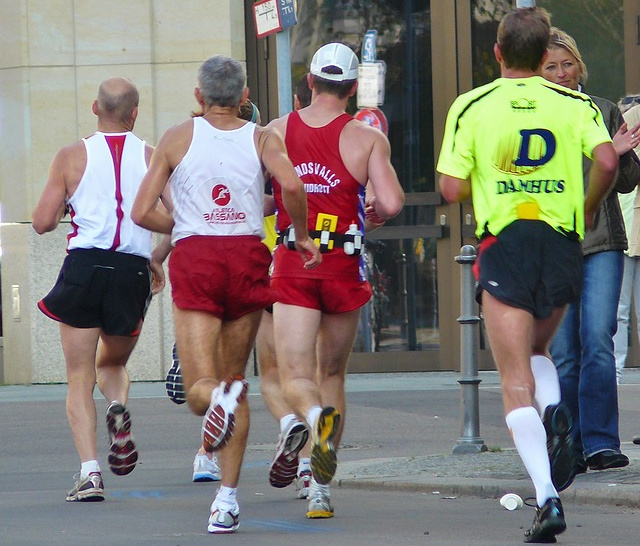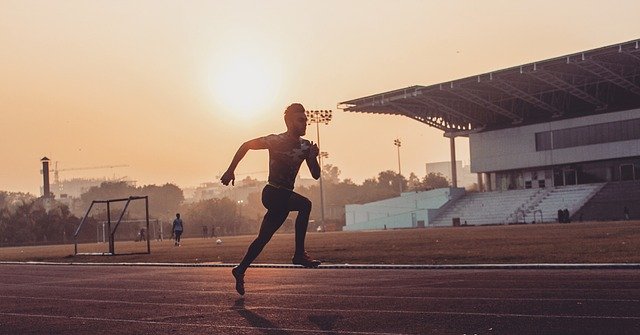Tight hamstrings are incredibly common among endurance runners. And that makes sense – the hamstring muscles are one of the largest muscle groups in the body.

Look at all those hamstring muscles!
But how do you differentiate between a common (but not serious) problem like tight hamstrings and a more serious version, an actual hamstring strain?
First, it’s always helpful to understand what we’re talking about.
The hamstrings are made up of three different hamstring muscles with hilarious names:
- Biceps femoris
- Semitendinosus
- Semimembranosus
It’s one of the largest muscle complexes in the body and this group has the herculean job of decelerating your lower leg when the quadriceps contract. This straightens the leg and acts as a brake, helping your knee avoid hyperextension with each stride.
Tight hamstrings – or even a hamstring strain – are usually caused by poor training or problems with running form.
Training factors that can cause hamstring injuries include:
- Too much speed training before you’re ready
- No strength training to make the muscles more resilient
- Big swings in weekly mileage (i.e., doing too much, too soon)
And the major aspect of running technique that can contribute to tight hamstrings is aggressive over-striding where you reach out in front of your body.
But you’re also at higher risk of a hamstring injury if you’ve already had an injury in this muscle, are sprinting while tired, or have an imbalance (stronger, more dominant quads can increase your risk of this particular injury).
Now that we have a better understanding of the hamstring muscle function and the training errors that can contribute to injuries, let’s differentiate between tightness and a strain.
Tight Hamstrings 101
Squats – no matter the implement used – are great for strengthening your legs
First, let’s get something out of the way: tight hamstrings are not a “real” running injury.
Sure, they can definitely feel annoying. And an aggravated hamstring may give you pause before running too long or doing certain types of speed work, especially maximum efforts like hill sprints.
But tightness is not the same as a true repetitive stress injury.
Tight hamstrings are still capable of carrying you through a run. You might experience a dull achiness or simply the sensation that your hamstring feels like a tightly coiled spring.
But if your hammies are just tight (rather than strained) you’ll probably:
- Not need to alter your form to run comfortably
- Feel that tightness improve after dynamic warm-up exercises or 1-2 miles of easy running
- Not experience any sharp, stabbing, or intense pain
- Feel fine running slow but experience some minor discomfort when trying to run fast
If that’s the case for your particular hamstring issue, then rejoice! You likely just have tight hamstrings rather than a strain.
Another way to determine if your hamstring injury is an actual strain or something more minor is to think back to when the pain began. More serious hamstring injuries like a strain (particularly Grade 2 or Grade 3) are often the result of a singular incident that you’ll remember.
Maybe you heard a “pop” sound, fell down, or immediately felt pain. That’s a good indication that you have some type of muscle strain rather than just some tightness.
But if you can’t find a specific accident in your running log, then it’s safe to assume you likely have a minor case of hamstring tightness.
Hamstring Strains 101

Strains are far more serious than simple tightness. And there are multiple types of strains that can affect your hamstrings, too:
- Grade 1: a “muscle pull” that doesn’t include any tearing of the muscle
- Grade 2: a partial tear of one of the hamstring muscles
- Grade 3: a complete tear of one of the hamstring muscles (sometimes the muscle can even pull off a piece of bone!)
If you think you might have a Grade 2 or 3 strain, it’s best to see a doctor or physical therapist. That’s a significant injury that requires medical attention.
These more serious strains often include bruising, substantial swelling, and an inability to walk or straighten your leg. You may need crutches to walk if your injury is a severe Grade 3 strain.
But a Grade 1 hamstring strain is something we can likely treat at home. Symptoms probably include:
- No bruising or swelling (or the swelling is minor)
- An ability to walk and straighten your leg
- Relatively minor pain
Grade 1 strains heal relatively quickly with conservative treatment. There’s no need to buy the value package from your local PT…
Hamstring strains can result in weakness in the muscle that persists for weeks or months long after the injury is healed. Much like putting your leg in a cast will cause those leg muscles to atrophy, a similar phenomenon happens with strains.
Because rest is so critical to healing a strain, the hamstring becomes underused. This causes an imbalance between the right and left muscles to develop.
To avoid these imbalances – and potentially months of disrupted training – it’s far easier to prevent your next hamstring injury.
How to Keep Your Hamstrings Happy
Healthy, pain-free hamstrings are supple, strong, and athletic hamstrings.
They’re also muscles free from poor training habits like:
- Building weekly mileage too quickly
- Adding speed work too soon before you’re ready
- Aggressively over-striding
So, let’s first make sure that your training is structured well. That is your first defense against running injuries – the workouts, long run progression, and overall mileage structure.
But after you’ve made sure your running is set up properly, what’s next? Our hamstring tightness video can help:
Next, follow these guidelines to keep your hamstrings healthy:
- Shred that core! Core exercises can help keep the pelvis in a neutral position and reduce strain on the hamstrings
- Get stronger! Strength training can help your hamstrings get stronger and more resilient to future injuries
- Quicker steps! Your cadence – or step rate – can reduce over-striding when it’s in the optimal range
- Stop stretching! Static stretching often exacerbates hamstring tightness because the muscle is already over-lengthened
- Sit less! Sitting can make hamstrings chronically tight so make sure you use a standing desk, vary your positions, and get up often
When you’re able to run again, include more mobility training in your running program.
This doesn’t necessarily mean formal work to become more mobile. It just means doing things that require mobility, like:
- Regular workouts that force you to run at a variety of speeds
- Very fast work like strides or hill sprints
- Hill workouts so you have to run against gravity
- Trail running to navigate technical terrain
- Foam rolling and self-massage to loosen muscles and promote blood flow
- Form drills that have you move through an exaggerated version of a stride
- Dynamic flexibility exercises to help you warm up before each run
- Strength training consistently to move through a variety of movements
- Cross-training (let’s not be one-trick ponies)
Of course, this is a lot to keep in mind when you’re running! Don’t try to implement these strategies all at once. Instead, pick 1-2 and get used to them over a few weeks before adding even more.
With properly structured training and a focus on strength, you’ll feel like my client Dorothy:
“I’m coming back from a pain-with-every-step hamstring injury. I’ve taken your recommendations into my rehab and very definitely, I’m coming out of this injury stronger and better prepared. I feel like a completely different runner. I feel closer to how I felt as a college athlete.
I have such a different outlook versus the pain and frustration I felt for all of last year. Thank you so much for your guidance!” – Dorothy
You can also have me do all this for you. We have quite a few training programs that give you a complete running plan so you don’t have to worry about scheduling or what to do on a daily basis.
Recover From a Hamstring Strain
Thankfully, many of the same strategies that we use to prevent a hamstring strain can help recover from one, too. Or if you’re chronically experiencing tight hamstrings, those prevention strategies will be very valuable.
To recap:
- Strengthen the core
- Strengthen the hamstrings
- Massage the hamstrings and surrounding tissues
- Check your form, particularly cadence
If you have a strain instead of simple hamstring tightness, you’re in luck! We have a formal treatment protocol for muscle strains included in our Injury Prevention for Runners program.
The full treatment program is complete with video demonstrations of effective strengthening exercises, myths and Q&A about the injury, what to do on a daily basis to get healthy, why it occurs, and how to modify your running once you can run again to prevent it from recurring.
You can also opt in here for our free injury prevention email series. You’ll get an overview of the program’s big ideas, case studies, and examples of what not to do.
And as a free gift, I’ll include our ebook The Little Black Book of Prevention & Recovery that includes the advice from 9 pro athletes.
You’ll hear from Ian Sharman, Dathan Ritzenhein, Joseph Gray, Amelia Boone, Max King, and more. Get started here!
